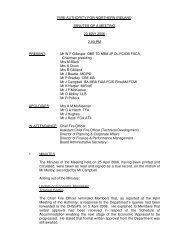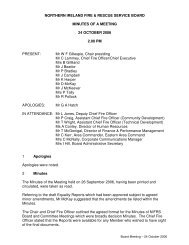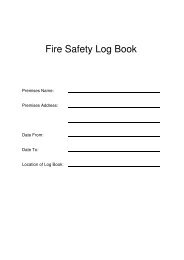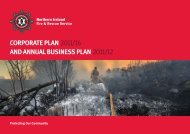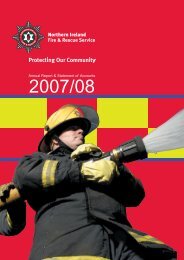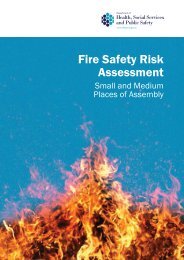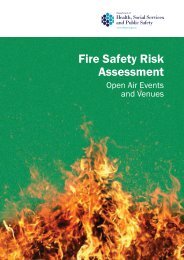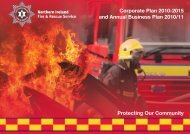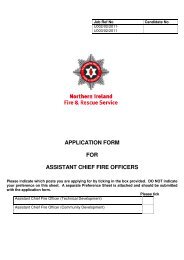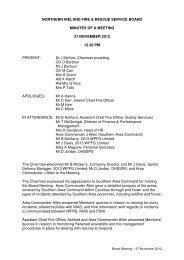A Guide To Reducing The Number Of False alarms From fire
A Guide To Reducing The Number Of False alarms From fire
A Guide To Reducing The Number Of False alarms From fire
Create successful ePaper yourself
Turn your PDF publications into a flip-book with our unique Google optimized e-Paper software.
A guide to reducing the numberof false <strong>alarms</strong> from <strong>fire</strong>-detectionand <strong>fire</strong>-alarm systems
Using this bookletIf an automatic <strong>fire</strong>-detection and <strong>fire</strong>-alarm system is used and maintainedproperly, its fast response to a <strong>fire</strong> that is just beginning can greatly reducethe risk to life and limit damage to property. However, features thatprovide this fast response can also cause false <strong>alarms</strong>.We have produced this booklet as part of an initiative we are taking withthe Chief and Assistant Chief Fire <strong>Of</strong>ficers’ Association (CACFOA) andthe British Fire Protection Systems Association (BFPSA) to reduce false<strong>alarms</strong> from automatic <strong>fire</strong>-detection systems.<strong>The</strong> aim of this booklet is to reduce both the nuisance caused by false<strong>alarms</strong> and the unnecessary costs which may be a direct or indirect resultof these <strong>alarms</strong>.<strong>The</strong> definition of a false alarm is:‘a <strong>fire</strong> signal resulting from a cause other than <strong>fire</strong>’.About 90% of automatic <strong>fire</strong>-detection and <strong>fire</strong>-alarm systems do notregularly cause false <strong>alarms</strong>. However, the remaining 10% are involved inmost false <strong>alarms</strong>. Every false alarm causes disruption. This may affectyour customer service, your productivity or the general routine of yourorganisation. <strong>The</strong> cost of false <strong>alarms</strong> in the UK is estimated to be about£1 billion a year. If you assessed the cost to your company you wouldprobably be surprised. One medium-sized company found that the averagefalse alarm at one of their sites cost them £1,200, and at another sitecosts amounted to around £126,000 in one year alone. However false<strong>alarms</strong> affect you, they could be a risk to the lives of others.2
<strong>The</strong> guidance given in this booklet is designed to help you to keep your<strong>fire</strong>-detection and <strong>fire</strong>-alarm systems in good working order.If you have been given this booklet, you will probably be:• responsible for a building’s <strong>fire</strong> protection;• an employer;• a tenant in a building which has several different occupiers; or• someone else working in a building.Make sure a copy of this booklet is available to the person responsiblefor the <strong>fire</strong>-detection and <strong>fire</strong>-alarm system. We give information aboutthe ‘responsible person’ on page 6.Please play your part in reducing false <strong>alarms</strong>.<strong>The</strong> effect of false <strong>alarms</strong> on the <strong>fire</strong> andrescue service<strong>The</strong> <strong>fire</strong> and rescue service’s main aim is to reduce the number of<strong>fire</strong>-related deaths and injuries by preventing <strong>fire</strong>s from starting or spreading.We need the <strong>fire</strong> and rescue service to help us with emergencies such as<strong>fire</strong>s and accidents on the road. Responding to false <strong>alarms</strong> diverts the<strong>fire</strong> and rescue service from their <strong>fire</strong>-prevention duties, or from dealingwith real emergencies. <strong>The</strong>y also disrupt work patterns and valuabletraining programmes.Almost half of the calls to the <strong>fire</strong> and rescue service are false <strong>alarms</strong>, andmost of these are false <strong>alarms</strong> from <strong>fire</strong>-detection and <strong>fire</strong>-alarm systems.3
According to the ‘Fire Statistics, United Kingdom’, in 2002 there were nearly280,000 false <strong>alarms</strong> from systems, and these types of call continue toincrease. This places an unacceptable burden on the <strong>fire</strong> and rescue service,and attending large numbers of false <strong>alarms</strong> can affect the motivation of<strong>fire</strong> service staff.<strong>False</strong> <strong>alarms</strong> not only waste the <strong>fire</strong> and rescue service’s valuable resources,they also cause increased dangers on the roads. Accidents involving <strong>fire</strong>engines responding to false <strong>alarms</strong> can and do happen. <strong>The</strong>se incidents,however rare, are unacceptable and need to be reduced.If your <strong>fire</strong>-detection and <strong>fire</strong>-alarm system is well designed and maintained,it should produce no more than one false alarm a year for every 50 detectorsfitted, and no more than one false alarm in any four-week period. For large<strong>fire</strong>-detection systems, we aim to reduce the level of false <strong>alarms</strong> wellbelow that of one a year for every 50 detectors.If your <strong>fire</strong>-detection system produces more false <strong>alarms</strong> than should beexpected, the <strong>fire</strong> and rescue service would consider it to be unsatisfactory.<strong>The</strong> person you employ to design and install a new <strong>fire</strong>-detection system,or to maintain an existing system, must be competent (that is, they musthave the necessary knowledge, training, experience and abilities to do thework). That person should be able to makesure that your <strong>fire</strong>-detection and <strong>fire</strong>-<strong>alarms</strong>ystem is designed, installed and maintainedto the highest possible standard.<strong>The</strong> level of competence of many contractorshas been independently certificated underan approved scheme. Your local <strong>fire</strong> andrescue service or the BFPSA can give youdetails of approved schemes.4
Your local <strong>fire</strong> and rescue service is always happy to give advice on any<strong>fire</strong>-safety matter including overcoming problems with false <strong>alarms</strong>. Pages7 to 12 of this booklet also give advice on common causes of false<strong>alarms</strong> and the action to take.Fire safety and the lawUnder <strong>fire</strong>-safety law, employers and othersresponsible for buildings must provide effective<strong>fire</strong> precautions to protect employees as wellas people who may be visiting or using theirproperty. Your <strong>fire</strong>-detection and <strong>fire</strong>-<strong>alarms</strong>ystem forms part of those <strong>fire</strong> precautions.A system that causes false <strong>alarms</strong> may not beefficient as people will gradually lose confidencein the <strong>fire</strong> alarm and start to ignore its warning.So it is important that you recognise theimportance of keeping the <strong>fire</strong>-detection and<strong>fire</strong>-alarm system in good working order and removing the causes of false<strong>alarms</strong>. <strong>The</strong> advice in this booklet will help you.It is also worth remembering that if a genuine <strong>fire</strong> alarm is ignored (forexample, because people mistake it for yet another false alarm), this canlead to death, injury and extensive damage. It is well known that manycompanies that suffer a serious <strong>fire</strong> will never effectively recover and willstop trading.5
<strong>The</strong> owners, occupiers, or other person with control over a building witha <strong>fire</strong>-detection and <strong>fire</strong>-alarm system should agree which of them will beresponsible for the system. That person should then nominate a suitableperson who agrees to be responsible for supervising the system. <strong>The</strong> personnominated should have received appropriate training or have the skills,knowledge or experience needed to make sure that:• the system remains in good working order and is properly maintained;• faults are dealt with quickly and efficiently;• those who have to take specific action when a <strong>fire</strong> alarm goes offhave appropriate training (see ‘Action to take’ on page 9);• false <strong>alarms</strong> are investigated and action taken to solve any problem;• activities which may affect the system (for example, processes whichmay produce heat or smoke, redecorating or a change in manufacturingprocesses) are controlled; and• maintenance or other work is carried out on the system only by acompetent person.If the person nominated needs training, you can get advice from:• the company that installed the <strong>fire</strong>-detection and <strong>fire</strong>-alarm system;• the company that maintains the system; and• your local <strong>fire</strong> and rescue service.If these organisations cannot providetraining, you can get further helpfrom the BFPSA. <strong>The</strong>ir details aregiven on page 14 of this booklet.6
Causes of false <strong>alarms</strong><strong>False</strong> <strong>alarms</strong> from <strong>fire</strong>-detection and <strong>fire</strong>-alarm systems can arise frommany different causes, most of which can be dealt with by careful planning.Typical causes of false <strong>alarms</strong> are:• pollutants in the air setting off smoke detectors;• extremely high temperatures setting off heat detectors;• vandalism or malicious acts;• mistakes in using the system;• the equipment being faulty or not being maintained properly;• <strong>fire</strong> detectors or red ‘break glass’ boxes being in the wrong place; and• the <strong>fire</strong>-detection system not being appropriate for the building orhow it is used.<strong>False</strong> <strong>alarms</strong> can come from three main devices – smoke detectors, heatdetectors and ‘break glass’ boxes.Smoke detectorsSmoke detectors respond to smoke and any similar pollutants in the air.If you have smoke detectors in your building, you must make sure thepeople in the building know about them.<strong>False</strong> <strong>alarms</strong> triggered by smoke detectors are often caused by:• cooking;• making toast;• insects, particularly in the summer months;7
• welding, soldering or similaractivities;• candles and open <strong>fire</strong>s;• steam;• dust;• aerosols; and• a lack of effectivemaintenance and cleaning.Heat detectors<strong>The</strong>se are generally used in kitchens, boiler rooms and similar areas wheresmoke detectors may be too sensitive and cause false <strong>alarms</strong>. <strong>The</strong>y areset to allow for expected temperature levels in the protected area, andwill trigger an alarm if the temperature goes above the expected level.<strong>False</strong> <strong>alarms</strong> may be caused by high temperatures in the protected area,or sudden increases in temperature.Break glass boxes‘Break glass’ boxes do not usually cause false <strong>alarms</strong> as a result of faultyequipment. However, the glass can be broken deliberately or by accident.If you think there is a high risk of this because of vandalism or where thebox is, they can be fitted with a transparent flap or cover that has to belifted before the glass can be broken.<strong>The</strong> actual cause of a false alarm may be easily identified and corrected.For example, if the cause is something someone has done (such as dustcoming from maintenance work), you can take action to prevent thisfrom happening again. However, you may need to take a more formalapproach to analysing the cause of the false alarm.8
Action to takeWhen the <strong>fire</strong> alarm sounds, everyone in the building should immediatelyfollow the <strong>fire</strong> action plan (this plan must be well publicised within yourbuilding). A trained member of staff may then find out if there is a <strong>fire</strong>(you should have arrangements in place so that you will know quicklywhether an alarm is genuine or false). If it is a false alarm, tell the <strong>fire</strong>and rescue service why it is a false alarm and be prepared to show themthe cause. This will help them to deal with the situation in the shortestpossible time.If you cannot find the cause of the false alarm, follow the proceduredescribed below.1 Silence the <strong>fire</strong> alarm but do not reset the control panel as this willget rid of the information you need to investigate the cause of thefalse alarm.2 Check the message on the control panel and find out where in thebuilding the false alarm came from.3 As soon as possible after the false alarm, visit that area and locate thebreak glass box, heat detector or smoke detector that set off the alarm.4 Try to find out why the break glass box or detector was triggered.<strong>The</strong> information on pages 10 and 11 may help you, but you may needto investigate further to find out the real cause (for example, vandalismor accidental damage to a break glass box or insects in a smoke detector).5 If you are having difficulty finding the detector that was triggered, itmay be in a duct or above a false ceiling. If a plan showing where alldetectors are is available, use it to find the detector. Break glass boxesshould be easier to find as they should be in clearly visible positions.9
6 If you cannot find the detector that was triggered, call in themaintenance company as they should know where detectors arewithin the <strong>fire</strong>-detection system.7 If the control panel does not show where the relevant detector is, orif no detector was triggered, call in the maintenance company as theproblem may be due to faulty equipment.8 Accurately record all the information about the false alarm in the systemlog book. This is very important as you may need the information ata later date.9 If false <strong>alarms</strong> continue, and you cannot find the cause or action youtake is unsuccessful, analyse when the false <strong>alarms</strong> happen and wherethey come from. This will help you to see if there is any pattern thatmay help you to identify the cause (for example, cooking before mealtimes or a boiler switching on early in the morning).10 Your investigations should show you that the false <strong>alarms</strong> are theresult of faulty equipment, malicious acts, human error, or activitiesnear detectors.Equipment faultsIf you can’t identify the cause of the false alarm, or if there seems to be afault in the system, turn the alarm off but do not reset the control panel.(If you have to reset the control panel, make special arrangements withthe company that installed or maintains your system to collect as muchinformation as possible before the control panel is reset.) <strong>The</strong> informationon the panel will help you to find the problem. If your equipment seemsto be faulty, call in the company that installed or maintains your system sothey can take appropriate action.10
If your alarm system automatically alerts an alarm receiving centre (an ARC),contact the ARC straight away. Tell them you are having problems with yoursystem and agree how they should handle any further <strong>alarms</strong> (to avoidneedlessly calling out the <strong>fire</strong> and rescue service) until the problem hasbeen fixed.Effective, regular maintenance, including cleaning the inside and outside ofsmoke detectors, will help to prevent equipment faults from happening inthe first place.Malicious actsThis cause can be the most difficult to identify and often needs to beinvestigated carefully. Examples of malicious acts include:• unnecessarily breaking the glass in break glass boxes;• unauthorised people having and using test keys for break glassboxes; and• deliberately directing smoke (for example, from a cigarette) into asmoke detector.Human errorsExamples of human errors include the following.• Building contractors carrying out hot or dusty work close to smokedetectors or heat detectors.• <strong>The</strong> <strong>fire</strong>-alarm system not being switched off while its wiring is being altered.Note: If you are planning on making changes to your <strong>fire</strong>-detection and<strong>fire</strong>-alarm system, consult your local <strong>fire</strong> and rescue service to find outif the changes would affect any <strong>fire</strong>-safety arrangements in the building.Also consider how the changes could affect the other <strong>fire</strong> precautionsin your building.11
• Unsecured control panels being activated, usually as a result of thepanel’s key or a similar device being left in the panel.<strong>The</strong>se incidents can usually be tackled by changing working practices (forexample, issuing permits to work) or giving information and training tostaff and contractors responsible for buildings.Activities near detectorsMany false <strong>alarms</strong> result from activities carried out near <strong>fire</strong> detectors,particularly smoke detectors. A common example is burning toast in atoaster. More examples are given on pages 7 and 8. This type of alarmcan be tackled by carrying out the activity elsewhere, fitting a temporarycover on a detector while the activity is being carried out, changing thetype of detector or moving it, or changing the way the <strong>fire</strong>-alarm systemresponds when a detector is triggered. If you use temporary covers ondetectors, these should be fitted only by approved staff and removedcarefully as soon as possible after the activity has ended. You can getmore advice from the company that installed or maintains the system.You should consider all the activities thatgo on in your building and develop aplan to avoid false <strong>alarms</strong>. Make sureyou have proper arrangements in placefor training staff on work processes andpractices, the <strong>fire</strong> precautions you have,and how work processes and practicesmay affect the <strong>fire</strong>-alarm system if theyare not carried out properly.12
MaintenanceLike all electrical systems, your <strong>fire</strong>-detection and <strong>fire</strong>-alarm system willbe effective only if it is maintained and regularly checked by a competentperson. Poor maintenance will not only lead to false <strong>alarms</strong>, it may alsolead to a genuine <strong>fire</strong> alarm being ignored or missed. It can also reduce thelife of the system. All these problems lead to extra costs for you. Guidanceon maintaining your system, together with guidance on reducing false <strong>alarms</strong>,can be found in BS 5839 Part 1 – Code of Practice for design, installation,commissioning and maintenance of <strong>fire</strong>-detection and <strong>fire</strong>-alarm systems.You can get a summary of the guidance given in BS 5839 Part 1, and adviceabout schemes that can help you assess the competence of contractors,from the website at www.bfpsa.org.uk or by phoning 020 8549 5855.Where do I go for more help?If you have followed the guidance in thisbooklet and false <strong>alarms</strong> are still causing aproblem, your local <strong>fire</strong> and rescue servicecan give you advice. You should also ask thecompany that supplied, installed or maintainsyour system to investigate the matter and takeappropriate action. <strong>The</strong> relevant company’scontact details should be on or next to the<strong>fire</strong>-detection and <strong>fire</strong>-alarm system control panel or printed in thesystem log book. If you cannot find their contact details, BFPSA canrecommend suitable organisations.If your <strong>fire</strong>-detection and <strong>fire</strong>-alarm system has been provided as acondition of any <strong>fire</strong>-safety law, you may have to consult your local <strong>fire</strong>and rescue service before you make any changes to your system.13
Useful contactsLocal <strong>fire</strong> and rescue service:Fire-alarm maintenance company:BFPSA – British Fire Protection Systems AssociationPhone: 020 8549 5855Website: www.bfpsa.org.uk<strong>Reducing</strong> false <strong>alarms</strong> will save you and the <strong>fire</strong> and rescueservice money, will reduce wasted efforts and may save lives.14
NotesUse the space below to make any notes you need.. . . . . . . . . . . . . . . . . . . . . . . . . . . . . . . . . . . . . . . . . . . . . . . . . . . . . . . . . . . . .. . . . . . . . . . . . . . . . . . . . . . . . . . . . . . . . . . . . . . . . . . . . . . . . . . . . . . . . . . . . .. . . . . . . . . . . . . . . . . . . . . . . . . . . . . . . . . . . . . . . . . . . . . . . . . . . . . . . . . . . . .. . . . . . . . . . . . . . . . . . . . . . . . . . . . . . . . . . . . . . . . . . . . . . . . . . . . . . . . . . . . .. . . . . . . . . . . . . . . . . . . . . . . . . . . . . . . . . . . . . . . . . . . . . . . . . . . . . . . . . . . . .. . . . . . . . . . . . . . . . . . . . . . . . . . . . . . . . . . . . . . . . . . . . . . . . . . . . . . . . . . . . .. . . . . . . . . . . . . . . . . . . . . . . . . . . . . . . . . . . . . . . . . . . . . . . . . . . . . . . . . . . . .AcknowledgementsThis guide has been produced by a forum made up of the British FireProtection Systems Association, the Chief and Assistant Chief Fire <strong>Of</strong>ficers’Association and the <strong>Of</strong>fice of the Deputy Prime Minister. <strong>The</strong> forum wouldlike to thank all those involved.We have been able to use the photographs in this booklet with the kindpermission of:• West Midlands Fire and Rescue Service;• ‘Fire’ Magazine; and• British Approvals for Fire Equipment.15
<strong>Of</strong>fice of the Deputy Prime MinisterEland HouseBressenden PlaceLondon SW1E 5DUPhone: 020 7944 4400Website: www.odpm.gov.uk© Crown copyright 2004This booklet (except the Royal Arms and logos) may be reproduced free ofcharge in any format as long as the reproduction is accurate and not used in amisleading way.<strong>The</strong> reproduction must be acknowledged as Crown copyrightwith the title and source of the publication shown.Published by the <strong>Of</strong>fice of the Deputy Prime Minister: Printed in the UK,February 2004 on material containing 75% recycled waste and 25% ECF pulp.Product code 04FPD01976




